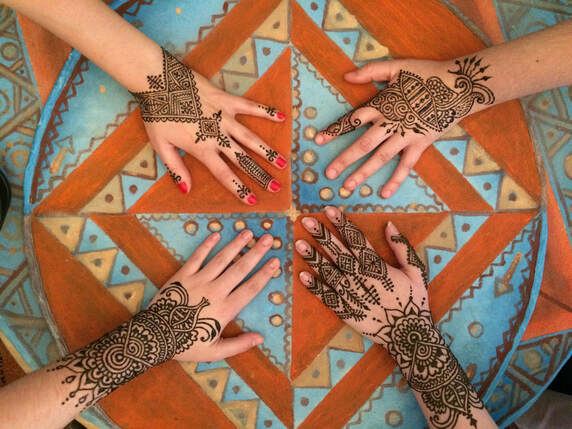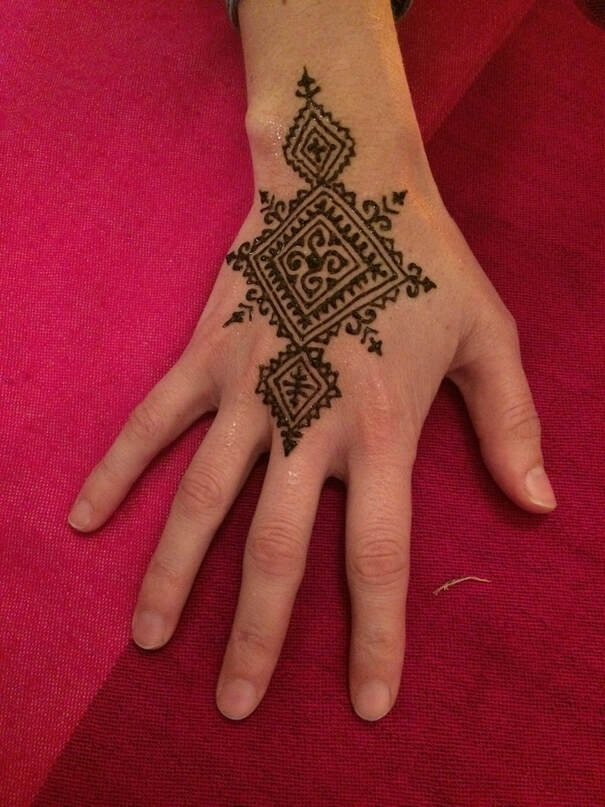Samples of Our Henna Designs
We use only Moroccan henna, and it is mixed fresh every day. Our henna paste never contains any chemical additives; it is 100% natural, containing only the dried and powdered leaves of the henna plant, lemon juice and sugar. We are the only provider of henna in all of Morocco that is certified by the International Certification For Natural Henna Arts. For additional information on natural, safe henna and the dangerous "black henna" that is used by many other, unscrupulous providers, see the articles posted below these photos.
The natural Moroccan henna powder we purchase comes packaged as a fine green powder. Our naqashas mix it with lemon juice and sugar, changing the color to a dark green that gradually darkens to a brown/black paste as it oxidizes. The paste is applied in fine lines on the skin, and is left to dry for 20-30 minutes. The naqasha then applies a solution of lemon juice and sugar which acts as a sealer to fix the henna paste in place. At this time, it is fine to leave the cafe. For the best possible results, the paste should be left on the skin for at least 6 hours. At that time, the henna paste may be removed, but water should be avoided until the next day. When the paste has been removed, the color of the tattoo will initially be an orange hue that will darken to a rich brown tone, reaching its deepest, darkest hue in 48 hours. The photos above all show the skin with the henna paste still in place.
The photos below show what the henna tattoo looks like after the paste has been removed. The final tone of the tattoo depends on a variety of factors, including your personal skin chemistry, if your skin has been properly cleaned and prepped for the henna, how long the henna paste was left on the skin, etc. The placement of the henna on the body is another determining factor. Henna stains skin the darkest in areas where the skin is thicker, like the palms of the hands and the soles of the feet. The henna tattoo will be lighter in areas of thinner skin as there is less keratin in those areas, necessary for the binding of the henna molecules to the skin. It is normal for a tattoo that begins on the fingers and travels up past the wrist to become progressively lighter, as you can see in the photo below.
A review of the research on the safety of natural henna shows that "reports of allergic contact dermatitis to natural henna are very rare in the literature. It can therefore be assumed that natural henna is a very weak skin allergen, and these allergic observations may be due to the addition of other components to henna in order to improve the quality of this product in terms of final color, time required to achieve the desired color and its lasting effect." (https://www.researchgate.net/publication/24196590_Allergic_contact_dermatitis_to_pure_Henna)
G6PD sensitivity to natural henna
If you have been told that you or your children have naphthoquinone sensitivity or the more serious genetic disorder called G6PD deficiency, then you are one of the small percentage of people who could have a reaction to henna.
Most people are aware of this disorder through anemic episodes from eating fava beans or anemia from exposure to naphthalene from mothballs. If your physician has ever told you that you or your children should not use aspirin or non steroidal anti-inflammatory drugs, consume fava beans or quinine, or be exposed to naphthalene fumes or mothballs, G6PD may be an issue and henna should not be applied.
The younger a child with G6PD deficiency, the more caution should be exercised. In an abundance of caution, we will not apply henna to children under the age of 5.
While natural henna is a safe product for almost everyone, the same can not be said of "black henna" which is often used by the women who masquerade as henna artists in Djemaa el Fna and other locations. Please read the description and warnings on the page we have created about black henna.
G6PD sensitivity to natural henna
If you have been told that you or your children have naphthoquinone sensitivity or the more serious genetic disorder called G6PD deficiency, then you are one of the small percentage of people who could have a reaction to henna.
Most people are aware of this disorder through anemic episodes from eating fava beans or anemia from exposure to naphthalene from mothballs. If your physician has ever told you that you or your children should not use aspirin or non steroidal anti-inflammatory drugs, consume fava beans or quinine, or be exposed to naphthalene fumes or mothballs, G6PD may be an issue and henna should not be applied.
The younger a child with G6PD deficiency, the more caution should be exercised. In an abundance of caution, we will not apply henna to children under the age of 5.
While natural henna is a safe product for almost everyone, the same can not be said of "black henna" which is often used by the women who masquerade as henna artists in Djemaa el Fna and other locations. Please read the description and warnings on the page we have created about black henna.
Proudly powered by Weebly


















